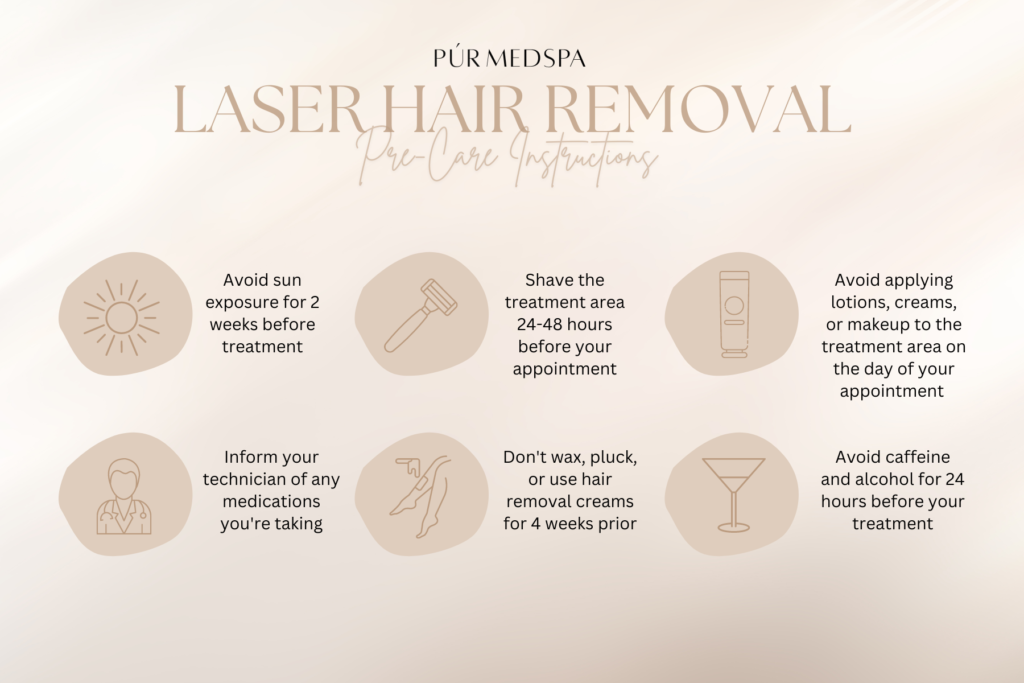Introduction:
Dermal fillers are a non-surgical solution for restoring facial volume, smoothing wrinkles, and enhancing facial contours, giving you a youthful and refreshed appearance. At Pur MedSpa, with locations in Plano, Frisco, and Southlake, we offer a range of dermal fillers, including Juvederm, Restylane, Revanesse, Radiesse, and Sculptra, to help you achieve your desired look. This guide will walk you through the pre-care and post-care instructions, explain the fillers available, and help determine if dermal fillers are right for you.
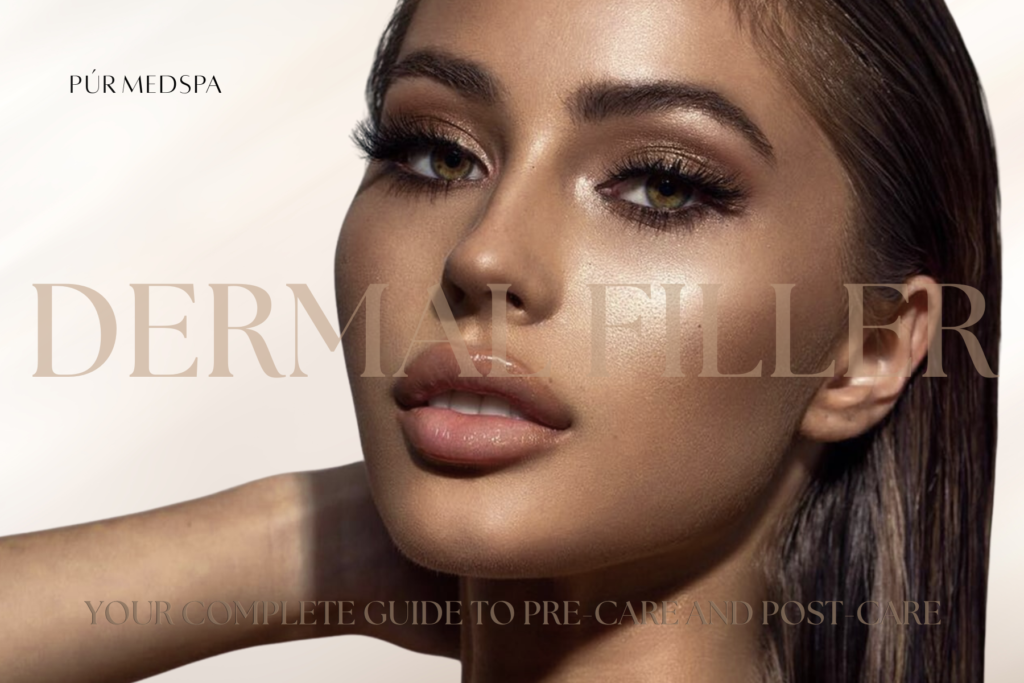
What Are Dermal Fillers?
Dermal fillers are injectable substances that help diminish facial lines, restore volume, and reduce signs of aging by smoothing wrinkles and adding fullness to face areas that have lost volume due to age. These non-invasive treatments make them a popular alternative to surgery for those looking to achieve a more youthful, refreshed appearance without extended downtime.
Most dermal fillers comprise hyaluronic acid (HA), a naturally occurring substance that helps keep skin hydrated and plump. Fillers can also be made from other materials, such as calcium hydroxylapatite and poly-L-lactic acid, each serving a different purpose depending on the desired result.
Commonly treated areas include:
- Diminish Facial Lines and Wrinkles:
Dermal fillers help smooth fine lines and deep wrinkles that develop as the skin loses collagen and elasticity. Areas commonly treated for wrinkle reduction include the forehead, crow’s feet around the eyes, and glabella lines between the eyebrows. - Restore Volume and Fullness in the Face:
With age, our faces naturally lose subcutaneous fat, leading to sagging skin and sunken cheeks. Dermal fillers are injected to re-plump these areas, restoring a youthful, lifted look. Volume restoration also targets temple hollows and under-eye hollows (tear troughs) that can make the face look tired or worn. - Reduce Signs of Aging:
Aging leads to volume loss in various areas of the face, such as the cheeks, jawline, and chin, causing sagging and creating shadows that emphasize wrinkles. Dermal fillers provide structural support, reducing sagging and giving the face a firmer, more youthful appearance. Fillers can also address jowls, often developing as skin loses elasticity around the jawline. - Minimize Skin Depressions and Scars:
Fillers can help minimize acne scars, pockmarks, and other types of skin depression. By injecting filler into the scarred area, the filler lifts the skin, smoothing out irregularities and creating a more even skin surface. - Address Fine Lines and Deep Wrinkles:
Dermal fillers effectively treat a wide range of wrinkle depths, from fine lines to deep folds. Fine lines around the mouth (like smoker’s lines) and eyes can be softened with smaller filler. In contrast, deeper lines, such as nasolabial folds (lines running from the nose to the corners of the mouth) and marionette lines (lines running from the mouth to the chin), may require more volume for correction. - Enhance Lips and Cheekbones:
Dermal fillers can plump thin lips, enhance lip symmetry, and create a more defined lip border. Additionally, fillers can be injected into the cheekbones to create a higher, more contoured look, lifting the overall facial structure and providing a more youthful appearance. - Define the Jawline and Chin:
As part of aging, the jawline can lose its definition, and the chin recurs, creating an imbalanced appearance. Dermal fillers can contour the jawline for a sharper, more defined look and add volume to the chin to improve facial proportions. - Lift Sagging Skin:
In some cases, dermal fillers can achieve a non-surgical facelift by restoring volume and lift to the face. This technique, sometimes called a liquid facelift, uses strategically placed fillers to lift and tighten sagging skin without requiring invasive surgery. - Enhance Facial Features:
Fillers are not only used for anti-aging but also to enhance facial features such as lip augmentation, cheekbone enhancement, and nose reshaping (known as a non-surgical rhinoplasty). These subtle enhancements provide a more balanced and aesthetically pleasing appearance.
Common Areas Treated with Dermal Fillers
Here’s a closer look at the specific areas commonly treated with dermal fillers:
- Nasolabial Folds (Laugh Lines)
- What it is: These deep lines run from the sides of the nose to the corners of the mouth.
- Why it’s treated: These lines become more prominent due to volume loss and sagging in the midface as we age. Dermal fillers can soften the appearance of these folds by plumping the surrounding tissue.
- Marionette Lines
- What it is: Lines that run from the corners of the mouth to the chin, often creating a sad or angry expression.
- Why it’s treated: Filling in marionette lines can help lift the corners of the mouth, giving a more youthful and pleasant appearance.
- Sunken Cheeks
- What it is: Volume loss in the cheeks leads to a hollowed or sunken appearance, often associated with aging.
- Why it’s treated: Fillers can restore fullness to the cheeks, creating a more lifted and youthful look while improving facial contour.
- Thin Lips
- What it is: Lips can become thinner and lose definition with age, or some individuals naturally have less fullness in their lips.
- Why it’s treated: Lip fillers plump lips, enhance lip shape and improve overall symmetry.
- Under-Eye Hollows (Tear Troughs)
- What it is: The hollowing beneath the eyes that can cause dark circles and a tired appearance.
- Why it’s treated: Fillers in this area can brighten and smooth the under-eye area, reducing the appearance of dark circles and giving a more rested look.
- Jawline Definition
- What it is: As we age, the jawline can lose definition, and jowls may start to form.
- Why it’s treated: Dermal fillers can redefine the jawline, giving it a sharper, more youthful appearance and reducing the appearance of jowls.
- Lips
- What it is: Lips can become thinner and lose volume over time, or some individuals may naturally have less full lips.
- Why it’s treated: Fillers are used to plump lips, create lip symmetry, and enhance lip borders.
- Temples
- What it is: The temples can hollow out with age, leading to an older or more gaunt appearance.
- Why it’s treated: Filling in the temples can help restore volume, creating a more youthful and balanced facial contour.
Benefits of Dermal Fillers
- Instant results with little to no downtime.
- Natural-looking enhancements that preserve your facial expressions.
- Versatility in treating various areas of the face for a customized result.
- Non-surgical and non-invasive, making it a great alternative to surgery.
- Long-lasting effects—depending on the filler, results can last anywhere from 6 months to 2 years.
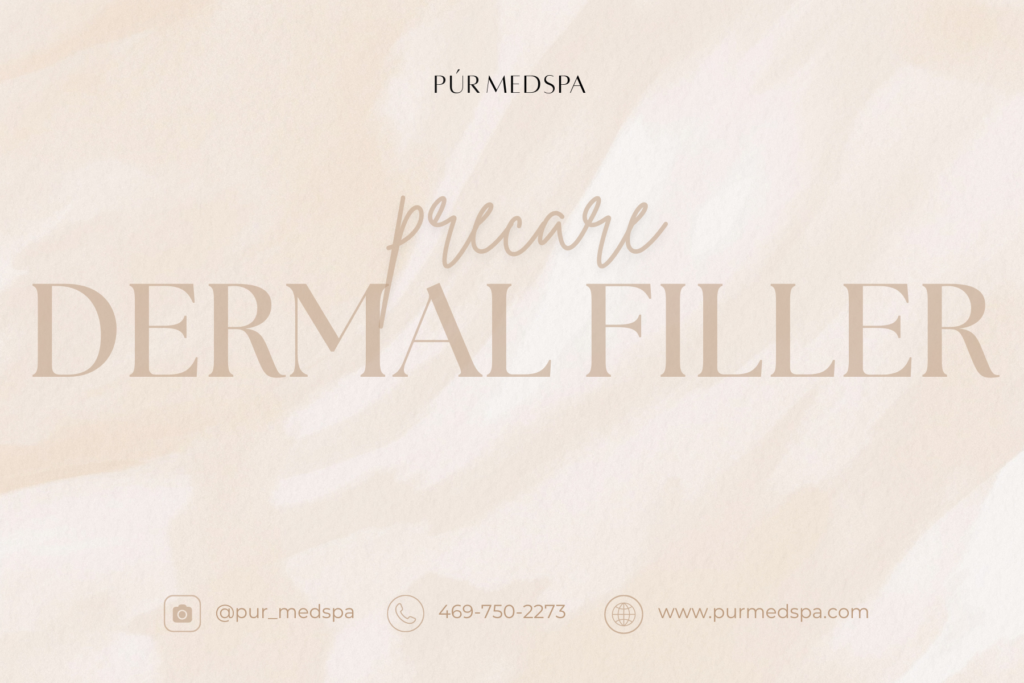
Pre-Care Instructions for Dermal Fillers
To maximize the effectiveness of your dermal filler treatment and minimize risks, follow these pre-care guidelines:
- Avoid blood-thinning medications:
To reduce bruising, stop taking aspirin, ibuprofen, and supplements like fish oil or vitamin E at least 7 days before treatment. - Limit alcohol intake:
Avoid alcohol for 24-48 hours before your appointment to minimize swelling and bruising. - Refrain from smoking:
Avoid smoking for 24 hours before your session, as it can delay healing and increase the risk of complications. - Avoid dental work and vaccines:
To reduce the risk of infection, schedule any dental work or vaccinations at least 2 weeks before or after filler treatment. - Stay hydrated:
Drink plenty of water before your treatment to keep your skin hydrated, improving the fillers’ effectiveness. - Take antiviral medication if needed:
If you have a history of cold sores, inform your provider. You may be prescribed antiviral medication to prevent an outbreak post-treatment. - Avoid certain skincare products:
To prevent skin sensitivity, discontinue retinoids, glycolic acids, or harsh exfoliants for 2-3 days before your session. - Arrive with a clean face:
Make sure to arrive with a clean face, free of makeup or moisturizers, to prepare the treatment area.
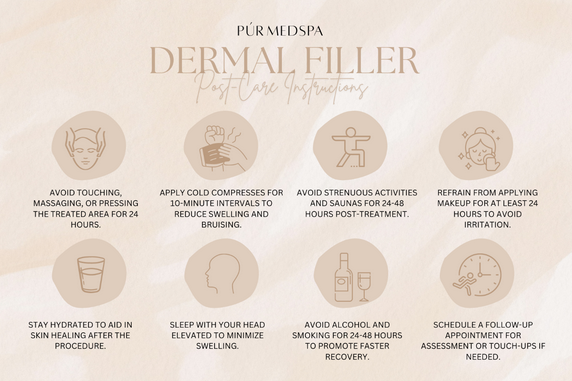

Post-Care Instructions for Dermal Fillers
Following these post-care instructions will help ensure optimal results and minimize any side effects:
- Avoid touching the treated area:
Refrain from massaging, rubbing, or touching the injection sites for at least 24 hours to allow the filler to settle properly. - Manage swelling and bruising:
Apply cold compresses to the treated areas for 10 minutes at a time to reduce swelling and bruising. - Stay hydrated:
Continue drinking plenty of water to support skin hydration and healing. - Avoid strenuous exercise:
Refrain from intense physical activities, hot yoga, or saunas for 24-48 hours to prevent excessive swelling. - No makeup for 24 hours:
Avoid applying makeup to the treated areas for at least 24 hours to reduce the risk of infection or irritation. - Sleep with your head elevated:
Sleep with your head elevated on pillows for the first night to reduce swelling. - Avoid alcohol and smoking:
Avoid alcohol and smoking for 24-48 hours post-treatment to aid in faster healing and reduce the risk of complications. - Follow-up appointment:
Schedule a follow-up appointment with your provider if needed to assess the results and perform touch-ups if necessary.
Eligibility for Dermal Fillers
Dermal fillers are suitable for most individuals looking to address issues such as facial volume loss, wrinkles, or lip enhancement. However, certain conditions may make someone ineligible for this treatment. Ideal candidates are those looking to:
- Enhance facial volume and restore youthful contours.
- Reduce the appearance of fine lines and wrinkles.
- Plump the lips or correct facial asymmetry.
You may not be eligible for dermal fillers if you:
- Are pregnant or breastfeeding:
Dermal fillers are not recommended for pregnant or breastfeeding women due to a lack of research on their safety. - Have active infections or inflammation:
If you have skin infections, acne, or inflammation at the treatment site, wait until the area has healed. - Have severe allergies or a history of anaphylaxis:
If you have a known allergy to lidocaine or any of the components in the filler, this treatment may not be suitable for you. - Are taking certain medications:
If you’re taking blood thinners, you may be at increased risk of bruising and should consult with your doctor before proceeding. - Have autoimmune conditions affecting healing:
Certain autoimmune disorders may affect the body’s ability to heal, increasing the risk of complications. - Have unrealistic expectations:
Dermal fillers provide subtle, natural-looking enhancements. It’s important to have realistic expectations and understand that the results are not permanent but can last 6-18 months depending on the product.
Types of Dermal Fillers Available at Pur MedSpa
At Pur MedSpa, we offer a variety of dermal fillers to suit your needs. Each filler has unique properties and is designed for different areas of the face. Here’s a closer look at the fillers we offer:
- Juvederm
What is it?
Juvederm is a hyaluronic acid-based filler that restores volume and smooths wrinkles.
Why use it?
It’s perfect for treating nasolabial folds, lip enhancement, and cheek volume loss.
Where is it used?
Juvederm is commonly injected into the lips, cheeks, under-eye hollows, and jawline. Results last 6-18 months.
- Restylane
What is it?
Restylane is another hyaluronic acid filler known for its natural-looking results.
Why use it?
It is versatile and used to treat fine lines, volume loss, and for lip augmentation.
Where is it used?
It’s often used in the tear troughs, lips, cheeks, and nasolabial folds. Results last 6-12 months.
- Revanesse
What is it?
Revanesse is a hyaluronic acid filler designed to deliver smooth, natural results with minimal swelling.
Why use it?
It’s ideal for lip enhancement and subtle volume in sensitive areas.
Where is it used?
Revanesse is commonly used for lip augmentation, nasolabial folds, and under-eye hollows. Results last 6-12 months.
- Radiesse
What is it?
Radiesse is made of calcium hydroxylapatite, which not only adds volume but also stimulates collagen production.
Why use it?
It is best for deeper wrinkles, facial contouring, and adding definition to the jawline.
Where is it used?
It’s great for the cheeks, nasolabial folds, and jawline. Results last up to 18 months.
- Sculptra
What is it?
Sculptra is a filler made from poly-L-lactic acid that works by stimulating collagen production over time.
Why use it?
It’s ideal for clients looking for gradual, long-term facial volume restoration.
Where is it used?
Sculptra is used in the cheeks, temples, and jawline. Full results take a few months to appear but last up to 2 years.
Frequently Asked Questions (FAQs)
Q: How long do dermal fillers last?
A: The duration of dermal fillers depends on the product used and the area treated. Most fillers last between 6-18 months, with some, like Sculptra, lasting up to 2 years.
Q: Are dermal fillers safe?
A: Yes, dermal fillers such as Juvederm, Restylane, and Revanesse are FDA-approved and considered safe when administered by trained professionals.
Q: What is the recovery time for dermal fillers?
A: Recovery time is minimal. Most patients experience mild swelling or bruising that subsides within a few days, allowing them to resume normal activities.
Q: Can dermal fillers be reversed?
A: Hyaluronic acid fillers like Juvederm and Restylane can be dissolved with an enzyme called hyaluronidase if you are unsatisfied with the results.
Q: Which filler is best for lip enhancement?
A: Juvederm and Revanesse are great options for lip enhancement, providing natural-looking fullness with minimal swelling.
Conclusion: Achieve Natural, Youthful Results with Dermal Fillers at Pur MedSpa
Dermal fillers provide a safe and effective way to enhance your facial features, restore lost volume, and reduce the appearance of wrinkles. Whether you want to plump your lips, smooth nasolabial folds, or contour your jawline, Pur MedSpa offers a variety of filler options to meet your needs. By following the pre-care and post-care guidelines in this comprehensive guide, you’ll be well-prepared for your dermal filler treatment and enjoy the best possible results.
Visit www.purmedspa.com to learn more or schedule a consultation at one of our convenient locations in Plano, Frisco, or Southlake.
Why You Should Consider Laser Hair Removal Before Thinning or Graying Hair
As we age, many individuals experience thinning or graying hair, which can significantly affect the efficacy of laser hair removal. Laser technology targets the pigment (melanin) in hair follicles, meaning darker hair responds best to the treatment. As hair begins to thin or turn gray, it loses the pigment that makes it an ideal candidate for laser treatment. Laser hair removal becomes less effective once hair becomes gray or white, as the laser has less melanin to target.
If you’re considering laser hair removal and are noticing early signs of thinning or graying hair, it’s essential to begin treatment sooner rather than later. By starting laser hair removal before these conditions become prominent, you can maximize the effectiveness of each session and achieve smoother, hair-free skin in the long term. Don’t wait until it’s too late—laser hair removal works best on pigmented hair, so scheduling your treatment early can ensure the best possible results.
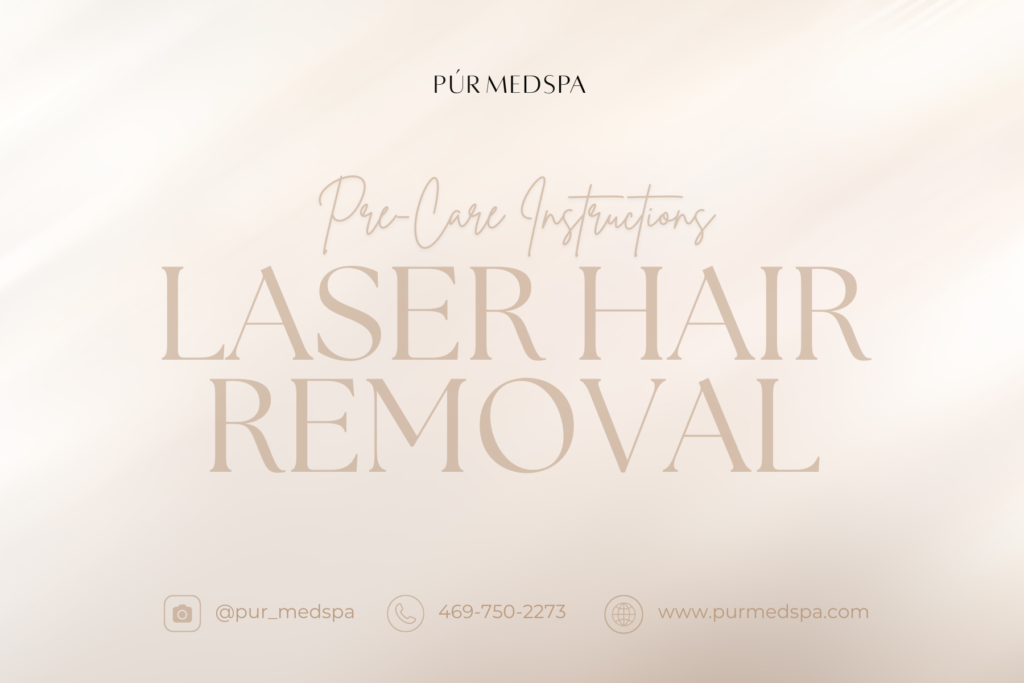
Pre-Care Instructions for Laser Hair Removal
Pre-Care Instructions for Laser Hair Removal
- Sun Protection:
- Avoid sun exposure for at least 2 weeks before your treatment to minimize the risk of burns or hyperpigmentation.
- If sun exposure is unavoidable, use SPF 50+ sunscreen on the treatment area.
- Hair Removal:
- Do not wax, pluck, or use hair removal creams for 4 weeks before your appointment as these methods remove the hair from the follicle, which is necessary for laser hair removal.
- Shave the treatment area 24-48 hours before your appointment to ensure that the laser can effectively target the hair follicles without burning surface hair.
- Skincare:
- Avoid applying lotions, creams, or makeup to the treatment area on the day of your session.
- Stop using retinoids, glycolic acids, or other harsh skincare products 7 days before your treatment to avoid irritation.
- Medications:
- Inform your Pur MedSpa technician of any medications you’re currently taking, especially those that may affect skin sensitivity.
- Avoid antibiotics and photosensitizing medications for 10 days prior to your treatment as they can increase skin sensitivity.
- Lifestyle:
- Avoid caffeine and alcohol for 24 hours before your session to reduce the risk of swelling or irritation.
- Medical Conditions:
- Notify your provider of any medical conditions, such as skin disorders or immune system issues, that may affect your eligibility for treatment.
If you’re considering laser hair removal and are noticing early signs of thinning or graying hair, it’s essential to begin treatment sooner rather than later. By starting laser hair removal before these conditions become prominent, you can maximize the effectiveness of each session and achieve smoother, hair-free skin in the long term. Don’t wait until it’s too late—laser hair removal works best on pigmented hair, so scheduling your treatment early can ensure the best possible results.
